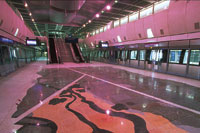Intensifying urbanization in developing countries and worsening congestion in developed ones are driving demand for extensions and upgrades to metro systems. Financing remains a key constraint to new construction, but this is spurring innovative program management techniques.
The metro market "is not huge," says Ed Pleuva, a director of U.K.-based design firm FaberMaunsell Ltd. But growing demand is reflected by a 3% annual rise in train car sales, says Dominique Pouliquen, senior vice president of product and strategy at Paris-based Alstom Transport S.A.
Alstom has 12 projects under construction globally. About half consist of new or extended lines, says Pouliquen. The majority are located in Asia and Western Europe. North America accounts for some 20% of projects.
"Growth in Asia is mainly triggered by new lines, while in Europe its mainly replacement of big fleets," says Pouliquen. Shanghai, for example, is building 181 kilometers of metro between 2000 and 2005.
 |  |
|
Growth. Although global subway projects are increasing as old systems age and developing countries grow, the market is slow to advance. (Photos courtesy of Parsons Brinkerhoff) | |
Typically, turnkey procurement accounts for about half the new metro work, with owners managing the rest, adds Pouliquen. Almost invariably, metro funding comes from public budgets, says David Powell, director for international metro business at London-based consultant Mott MacDonald Group. But his firm is among those preparing to bid for one exceptiona project in Milan, Italy, to be 20% contractor-funded.
|
Private financing for a proposed metro in Thessaloniki, Greece, failed, says Pouliquen. A consortium led by Bouygues Group, Paris, won the bid, but the contract floundered after long negotiations. Now its on the market again as a turnkey project, he notes.
In contrast, a complicated private financing deal is taking shape for London Underground Ltd., the worlds first metro system. Keeping train operations under public control, the government divided train and infrastructure maintenance and enhancement into three privately financed 30-year contracts.
To prepare, LUL divided infrastructure and train maintenance crews into three shadow infrastructure companies, or "infracos." Each took charge of one-third of the network and acted as a company, earning fees, penalties and bonuses, says Geoff Virrels, who ran one infraco with a 2,000-member staff.
A consortium including Bechtel Corp., San Francisco, signed the first contract in 2002. The following April, Metronet signed contracts for the remaining two sections. Metronet is owned by WS Atkins plc, Epsom and London-based companies Balfour Beatty Construction Ltd. and RWE Thames Water Ltd.
| RELATED ARTICLES |
|
|
Committed investment by the three companies in the first 7.5 years will reach $17.5 billion, rising to nearly $30 billion over 30 years. During the first year, LUL paid the three contractors nearly $2 billion in fees. The contracts are so complicated that bidding costs exceeded $800 million, says the National Audit Office.
"This is the mother of all complex infrastructure projects," says Peter Zuk, new chief program officer at LUL. In the first two years of the contracts "some modest accomplishments have occurred, but we are just beginning," says Zuk.
"The early days were a very, very steep learning curve," says Metronet Executive Chairman John Weight. "We got 3,000 people transferred [from LUL]." Metronets work force has increased and presently employs about 5,000 people.
The contracts feature the use of output specifications. Rather than telling the contractors what work is needed, LUL sets targets such as train punctuality, says Virrels, who now heads a LUL team on one of Metronets two sections. Only station enhancements are conventionally "input specified."
To define work, contractors provide a detailed plan for the next year and in less detail for the next 7.5 years. Regular meetings monitor progress and LUL moni-tors site work. "I dont mind as long as
it doesnt interfere," says Stephen Hall, Metronets strategic program director. Though technical due diligence established the systems condition, the contractors still must inspect 15,000 "grey assets" such as bridges, says Hall.
 |
| Digging Deep. Publicly funded heavy rail project in Delhi, India, includes cut-and-cover, NATM and hard rock tunneling methods. |
The estimated $2.3-billion system taking shape in Delhi, India, is one of the worlds largest major publicly funded heavy rail projects. Delhi Metro Rail Corp. Ltd. commissioned the initial 8-km-line two years ago, and another 14.1 km has opened since. A five-firm general consultant team including Parsons Brinckerhoff, New York City, aids the owner.
The 25-km third line is to start operation late next year. The 10.6 km of tunnels running north-south through the central business district is divided into two turnkey civil contracts. A consortium including Skanska A.B., Stockholm, won the $220-million cut-and-cover job for the northern 4.1 km in 2001 and is to be finished in December.
Munich-based Dywidag International GmbH leads a consortium on the $400-million southern contract, which started in April 2001. The southern 6.5 km is mostly bored with five cut-and-cover stations, says Derek Winsor, project director for design firm Mott MacDonald. One station and a short section used the New Austrian Tunneling Method.
The team used two earth pressure balance machines for clay sections plus a hard rock tunneler. Train service is due to start next June in one station as a showcase. Other stations are not due for full completion until March 2006.


Post a comment to this article
Report Abusive Comment